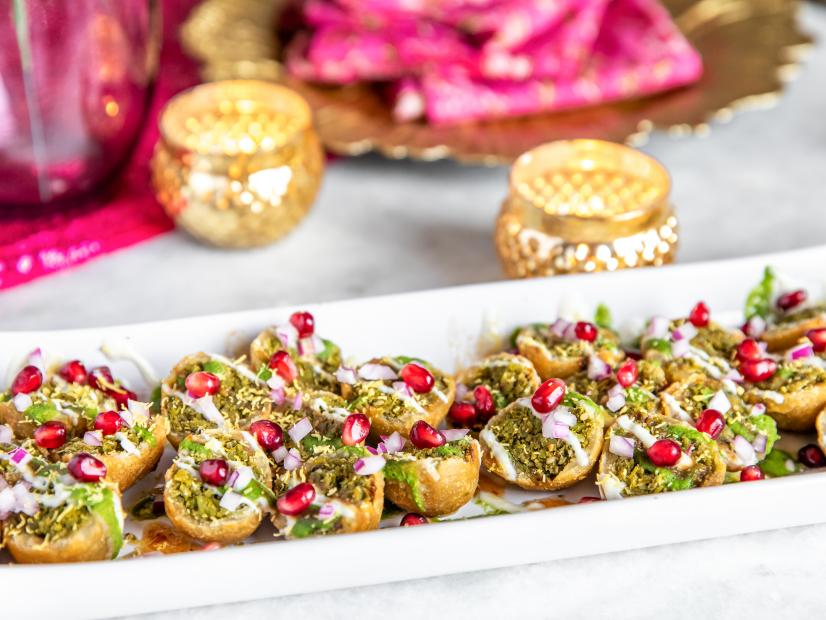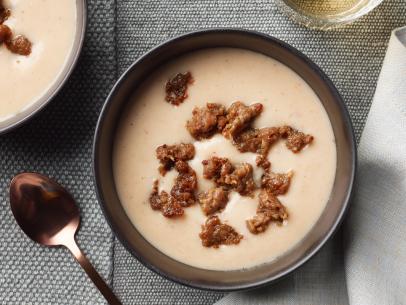
Lilva Kachori
- Level: Intermediate
- Total: 1 hr 20 min (includes cooling time)
- Active: 1 hr 10 min
- Yield: 15 to 20 pieces
-
- Nutritional Analysis
- Per Serving
- Serving Size
- 1 of 8 servings
- Calories
- 254
- Total Fat
- 10 g
- Saturated Fat
- 2 g
- Carbohydrates
- 35 g
- Dietary Fiber
- 4 g
- Sugar
- 3 g
- Protein
- 6 g
- Cholesterol
- 0 mg
- Sodium
- 288 mg
- Level: Intermediate
- Total: 1 hr 20 min (includes cooling time)
- Active: 1 hr 10 min
- Yield: 15 to 20 pieces
-
- Nutritional Analysis
- Per Serving
- Serving Size
- 1 of 8 servings
- Calories
- 254
- Total Fat
- 10 g
- Saturated Fat
- 2 g
- Carbohydrates
- 35 g
- Dietary Fiber
- 4 g
- Sugar
- 3 g
- Protein
- 6 g
- Cholesterol
- 0 mg
- Sodium
- 288 mg
Ingredients
Dough:
Filling:
Directions
Special equipment:
a deep-fry thermometer- For the dough: Put the flour in a large bowl and make a well in the center. Add the 2 tablespoons oil and 1 teaspoon salt to the well. Rub together with your fingertips until the mixture resembles fine breadcrumbs. Add the lime juice, then the cold water 2 tablespoons at a time and knead the dough until soft and pliant, 3 to 5 minutes. Cover the dough with a kitchen towel and let rest at room temperature for 20 minutes.
- Meanwhile, for the filling: Add the green peas, tuvar lilva, coconut, ginger and chiles to a food processor. Pulse until the mixture becomes a coarse paste, 8 to 10 pulses. Set aside.
- Heat the oil in a large nonstick saute pan over medium heat. Add the pea mixture and cook, stirring occasionally, until it is almost dry and does not stick together, 10 to 12 minutes. Stir in the cumin, garam masala, cayenne, coriander, turmeric and cinnamon. Cook, stirring occasionally, until there is little to no moisture left in the pan and the peas are still bright green, 5 to 7 minutes. Season with salt, then stir in the cilantro, cashews, sugar and lime juice. Transfer to a large bowl. Set aside until cool to the touch, about 10 minutes.
- To assemble: Roll the rested dough into a ball. Rub 1 teaspoon oil on your hands and pat the dough until completely coated; this will keep it moist.
- Roll out 1 tablespoon of dough into a 3-inch round on a lightly floured surface. Place 1 heaping teaspoon of the filling in the center. Bring together the edges of the dough so the seam is on top of the filling. Tightly pinch the edges closed to seal the filling inside. Trim off any excess dough. Roll the parcel into a ball with your palms and place it on a parchment paper-lined baking sheet. Repeat with the remaining dough and filling to make 15 to 20 parcels.
- Pour enough oil to fill a large pot or Dutch oven about a third of the way. Heat over medium heat until a deep-fry thermometer registers 300 degrees F. Working in batches of 5 or 6, gently lower the kachori into the hot oil using a spider and gently fry until the dough is golden brown, 5 to 7 minutes (see Cook’s Note). Transfer to a wire rack set inside a baking sheet. Serve warm or at room temperature.
Cook’s Note
If tuvar lilva are not available, you can use shelled edamame. To toast the shredded coconut, spread it out on a parchment-lined baking sheet and bake at 325 degrees F until golden, rotating halfway through, about 6 minutes total. Check frequently, as it can burn quickly. Slowly frying the kachori creates an extra crispy exterior.
Looking for Something Else?
Related Pages
- Fried Green Bean Casserole Recipe
- How to Turn Almost Any Powder into a Dalgona...
- Flat Rice Bread from Southern India
- Hibiscus Sorbet Recipe
- Matar Kachori Recipe
- Herbed Desai Vada with Cilantro Chutney Recipe
- Next Food Network Star, Season 6
- Variation
- What's the Difference Between East Coast Butter...

































